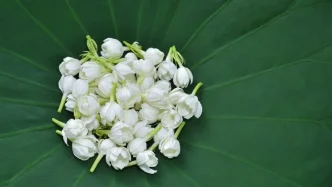In a striking image from Bangkok, red roses lie in front of the Trimurti Shrine, a symbol of devotion and beauty. Yet, recent studies have cast a shadow over such floral offerings in Thailand, revealing that more than half of the country’s edible flowers are contaminated with hazardous pesticides. Presented at a major medical conference earlier this month, these findings have sparked urgent questions about food safety, agricultural practices, and public health in a nation where edible flowers are both a cultural staple and a culinary delight.
A Widespread Problem Unearthed
Two separate studies, conducted by researchers from Thailand’s Department of Medical Sciences and regional offices, have uncovered alarming levels of pesticide residue in edible flowers sold across the country. The first study, led by Ratiyakorn Srikote of the Food Quality and Safety Office, sampled 192 edible flowers from gardens and markets in 13 health zones nationwide. The results were stark: 59.9% of the samples—115 in total—tested positive for pesticide contamination. These samples contained traces of 33 different types of pesticides, with concentrations ranging from 0.01 to 6.2 milligrams per kilogram.
A second, smaller study by Pasurat Settaphan and Sasithorn Sukreetha from the Ninth Medical Sciences Office in Nakhon Ratchasima echoed these concerns. Examining 18 samples of roses, vegetable hummingbirds, wild ramose herbs, and cowslip creepers, the researchers tested for 132 types of pesticides. The findings confirmed the presence of harmful chemicals, with chlorfenapyr, carbendazim, and carbaryl among the most commonly detected. These pesticides, often used to protect crops from pests, are known to pose risks to human health when ingested in significant amounts, potentially causing neurological damage, respiratory issues, and other long-term effects.
These revelations, presented at the 33rd Medical Academic Meeting held from July 11 to 13 at the Impact Forum in Muang Thong Thani, Nonthaburi, highlight a pervasive issue in Thailand’s agricultural sector. Edible flowers, often consumed raw in salads, garnishes, or traditional dishes, are particularly vulnerable to contamination, as they are not typically cooked or processed in ways that might reduce pesticide residues.
Health Risks and Cultural Implications
The contamination of edible flowers is more than a scientific concern; it strikes at the heart of Thai culture and cuisine. Flowers like roses and cowslip creepers are not only used in everyday meals but also play a significant role in religious offerings and ceremonies, as seen at shrines like Trimurti in Bangkok. The idea that these symbols of purity and devotion could carry toxic residues is deeply unsettling for many Thais.
Public health experts are now sounding the alarm about the potential risks of long-term exposure to these chemicals. While the detected levels in the studies may not cause immediate harm, chronic consumption of contaminated flowers could accumulate in the body over time, leading to serious health issues. Vulnerable populations, such as children and pregnant women, are particularly at risk. Yet, without widespread awareness or immediate regulatory action, consumers remain largely uninformed about the dangers lurking in their food.
Agricultural Practices Under Scrutiny
The high prevalence of pesticide contamination points to broader systemic issues in Thailand’s agricultural practices. The country is one of the world’s leading producers of agricultural goods, and pesticides are widely used to maximize yields and protect crops from pests in its tropical climate. However, the overuse or misuse of these chemicals—often due to inadequate training for farmers or lax enforcement of regulations—has long been a concern for environmentalists and health advocates.
Edible flowers, grown both commercially and in small-scale gardens, often fall through the cracks of regulatory oversight. Unlike staple crops such as rice or fruits, which are subject to more stringent testing, flowers are not always prioritized in food safety protocols. This gap in monitoring has allowed contaminated products to reach markets and dining tables unchecked.
Environmental groups have also raised concerns about the impact of pesticide runoff on Thailand’s ecosystems. Chemicals like chlorfenapyr and carbaryl can contaminate soil and water sources, harming wildlife and disrupting delicate balances in rural areas where many edible flowers are cultivated. The dual threat to human health and the environment underscores the urgent need for reform in how pesticides are managed and applied.
Calls for Action and Accountability
The findings from these studies have prompted calls for immediate action from various stakeholders. Health officials are urging the government to implement stricter regulations on pesticide use, including mandatory testing of edible flowers before they reach consumers. There is also a push for public education campaigns to inform citizens about the risks of consuming untested flowers and to encourage safer alternatives, such as organically grown produce.
Farmers, too, are caught in a difficult position. Many rely on pesticides to protect their livelihoods from pests and diseases, yet they often lack access to safer, more sustainable alternatives or the training needed to use chemicals responsibly. Support from agricultural agencies—such as subsidies for organic farming methods or workshops on integrated pest management—could help bridge this gap, reducing reliance on hazardous substances without sacrificing crop yields.
Meanwhile, consumers are beginning to demand greater transparency in the supply chain. In markets across Bangkok and beyond, shoppers are increasingly asking vendors about the origins of their flowers and whether they have been treated with chemicals. This growing awareness, while still nascent, could pressure producers and policymakers to prioritize food safety over short-term profits.
Looking Ahead: A Path to Safer Flowers
As Thailand grapples with the fallout from these studies, the path forward remains uncertain. Will the government step in with robust regulations to protect its citizens, or will the issue of pesticide contamination continue to linger in the background of the nation’s food system? For now, the image of red roses at the Trimurti Shrine serves as a poignant reminder of the intersection between beauty, tradition, and the hidden dangers that modern agricultural practices can bring.
The hope is that these findings will serve as a wake-up call, spurring collaboration between policymakers, farmers, and consumers to ensure that edible flowers—symbols of Thailand’s rich cultural heritage—can be enjoyed without fear. Until then, the nation watches and waits, wary of the unseen toxins that may lie within even the most delicate of petals.
















